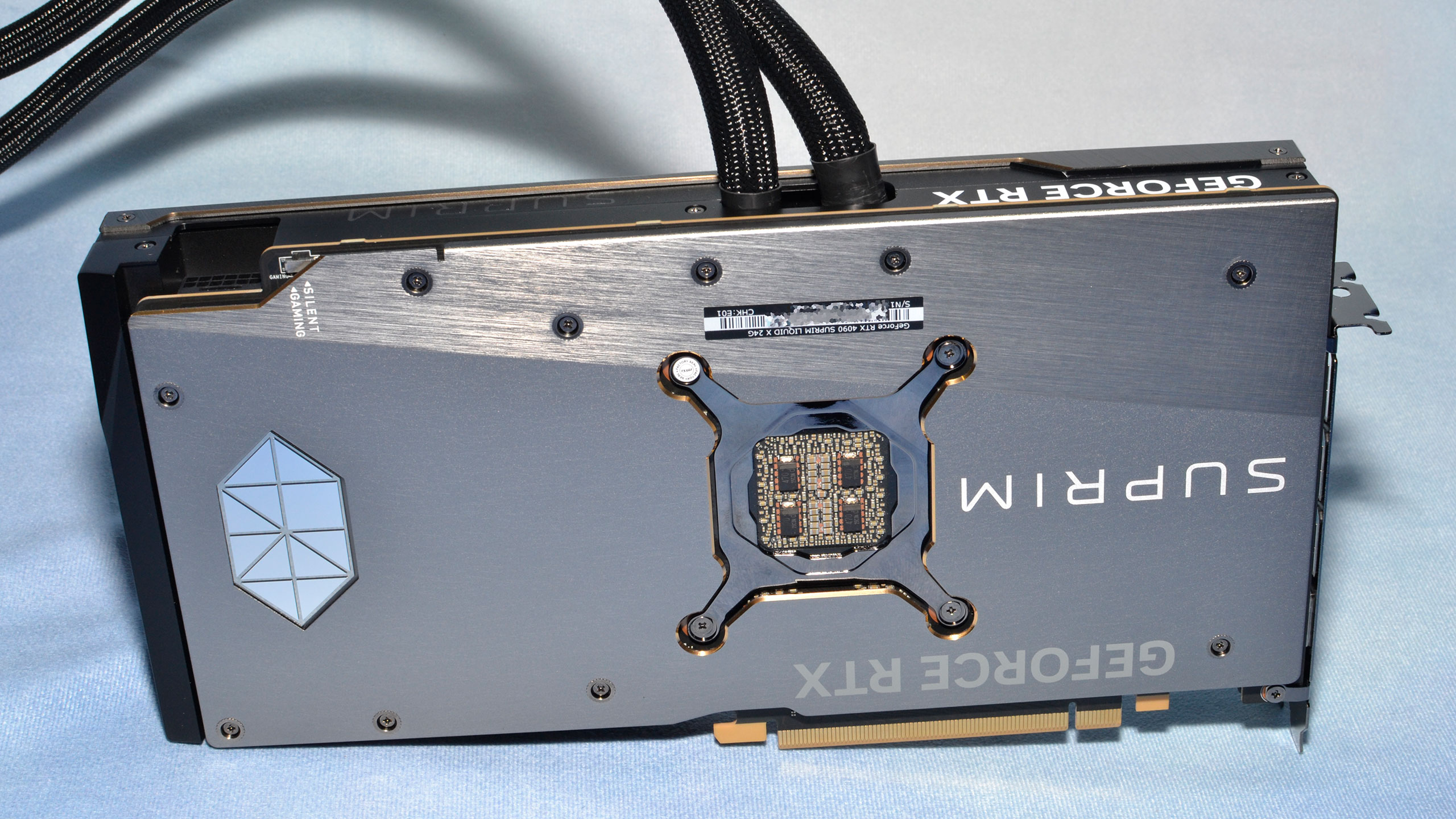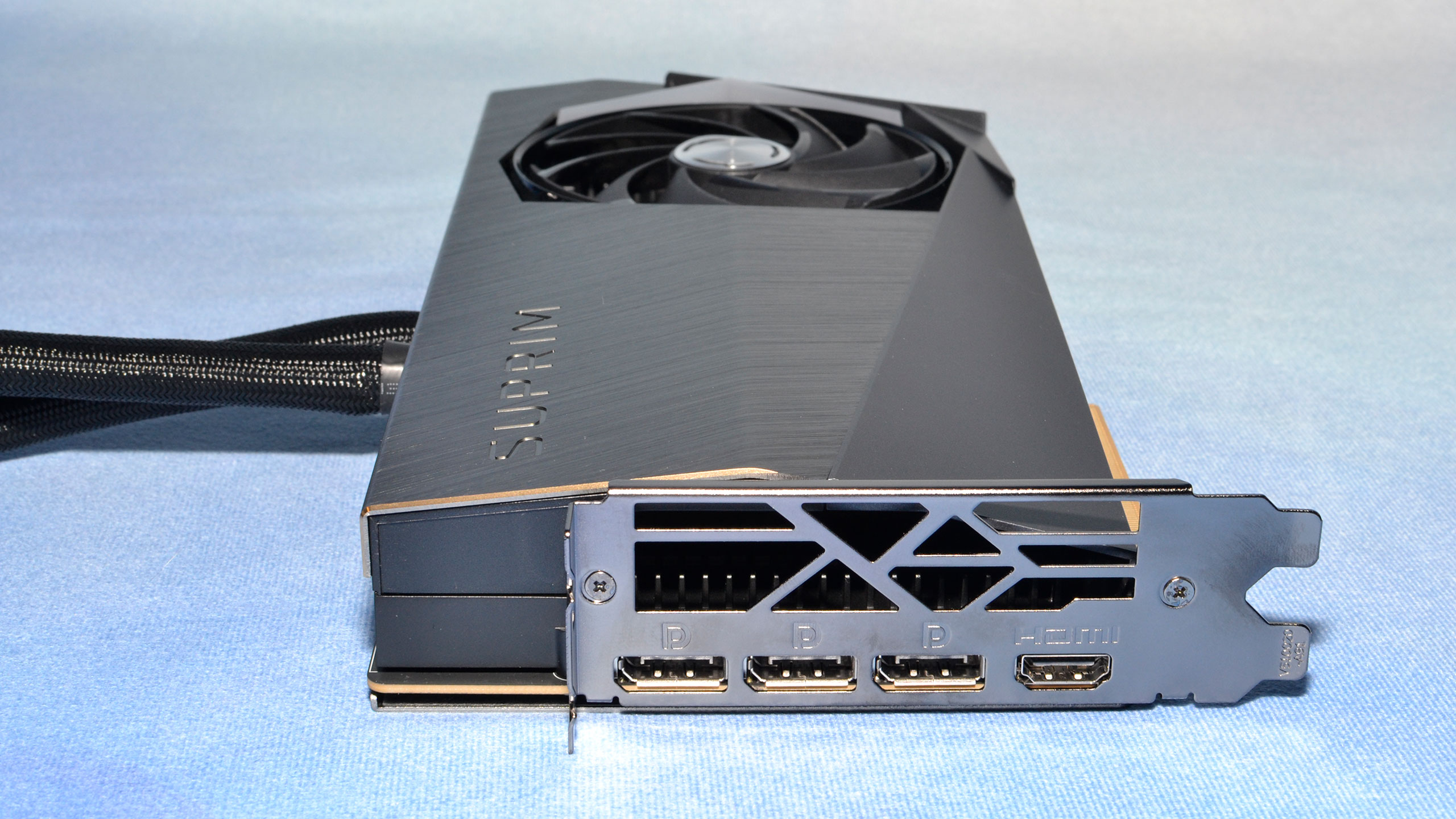Why you can trust Tom's Hardware
The MSI RTX 4090 Suprim Liquid X boldly chooses to live and die by its use of liquid cooling. If you're a fan of all-in-one coolers, or if you prefer a smaller card with an attached radiator over a huge chonker like the Asus 4090 ROG Strix — or really just about any of the air-cooled 4090 cards — this might be the 4090 you're looking for.
By the same token, true liquid-cooling enthusiasts might prefer a custom cooling setup. That way, you end up with a single pump, reservoir, and radiator instead of needing to find room for a second radiator — assuming you've also got a liquid-cooled CPU. Considering both AMD and Intel CPUs that would be appropriate for use with an RTX 4090 all recommend at least a 240mm radiator, adding a second AIO for the graphics card means you'll need a rather large case, at which point we have to ask whether the MSI AIO even makes sense.
Nearly all of the performance characteristics from the MSI card show it to be equal to Nvidia's Founders Edition — equal to but not better. The Asus ROG Strix managed a slightly higher overclock on the GPU core, and a substantially higher GDDR6X overclock likely due to the silicon lottery. But then it also costs quite a bit more.
MSI's pricing at least isn't too odious, as far as RTX 4090 cards go — at least not after MSI dropped back to $1,749 after initially raising the MSRP by $185. $150 extra for a premium liquid-cooled graphics card is typical of what we've seen in the past, especially on top-shelf GPUs like the 4090. That's assuming you can find a card for that price, however. Right now virtually all 4090 cards are sold out or severely overpriced.
The MSI Store on Amazon for example shows four different models, starting at $2,425 for the Gaming Trio and going up to $2,998 for the Suprim Liquid X. Welcome to scalper pricing, courtesy of Amazon's third-party marketplace! Hopefully such price gouging proves to be short-lived. The RTX 4090 currently sits uncontested as the fastest GPU for gaming and (some) professional uses, but once other options like the upcoming RTX 4080 and AMD's RDNA 3 GPUs arrive, perhaps prices will return to MSRP.
Both of those should arrive within the next month. Both will almost certainly sell out quickly at launch, but of course all the gamers who already managed to snag an RTX 4090 won't be looking to buy a second lower-tier 4080. Scalpers on the other hand… well, we can only hope demand isn't so high that scalpers can continue to flip cards for a profit. The only way to win that game is to simply refuse to play.
Overall, the MSI RTX 4090 Suprim Liquid X is an elegant looking option for anyone who wants a liquid-cooled card and has room for it in their PC build. That's a pretty specific market niche, so if you don't fit into that box, take a look at the other RTX 4090 cards instead. They're proving to be just as capable, in both speed and cooling performance.
- MORE: Best Graphics Cards
- MORE: GPU Benchmarks and Hierarchy
- MORE: All Graphics Content
Get Tom's Hardware's best news and in-depth reviews, straight to your inbox.
Current page: MSI RTX 4090 Suprim Liquid X: Stay Hydrated
Prev Page MSI RTX 4090 Suprim Liquid X: Power, Temps, Noise, Etc.
Jarred Walton is a senior editor at Tom's Hardware focusing on everything GPU. He has been working as a tech journalist since 2004, writing for AnandTech, Maximum PC, and PC Gamer. From the first S3 Virge '3D decelerators' to today's GPUs, Jarred keeps up with all the latest graphics trends and is the one to ask about game performance.
-
Ltsmba $150 extra for essentially 0 performance gain over the FE 4090. So it takes up a little less space in the case, and looks a little more sleek. I'd probably pay $50 extra for that, but definitely not $150 (more actually for some people who bought it when MSI raised the price even higher temporarily).Reply
I thought the point of a water cooled card was to push the limits of what the GPU could do, but it seems its more of a limitation of how much power you can put into the 4090, not how hot its getting.
Water cooling on these things kinda seems completely overkill, unless i'm missing something, which I might be.
Even if I am missing something, I feel bad for anyone who paid a premium for this card and is getting no boost over the FE 4090... -
Phaaze88 It's technically still a 4-slotter, just split in half, with the 2 halves connected by 470mm long tubes. Depending on how you look at it, it's actually larger than some air cooled models...Reply
Msi seems to have slipped up on the contact pressure, because both Kitguru and Paul's HW show the memory being rather warm...
The cards are hard voltage limited by Nvidia. Previously, they were power limited.Ltsmba said:Water cooling on these things kinda seems completely overkill, unless i'm missing something, which I might be.
Without DIY voltage modding, there isn't much on the table. So AIB models don't offer much more than aesthetics compared to the FE. -
Ltsmba That's good to know that it's a voltage limit rather than a power limit.Reply
I guess even so, it ends up being the same result, no benefit to buying a more expensive AIB model.
It's looking more and more clear why EVGA bailed -
A Stoner While performance wise it might not be a gain, if it reduces actual temperatures, then you will be bleeding less heat into your computer room. Not sure if that is the case here, but I am currently running the same watts on my old newer computer than my older old computer and the newer one causes far less heat buildup in the room. The reason is that the CPU and GPU run at much lower top temperatures than the older ones. I think my CPU tops out at 75 water cooled and the GPU at 92. The older one is 100 CPU water cooled or air cooled and 105 GPU.Reply -
JarredWaltonGPU Reply
I thought I included this, but perhaps not. Across the gaming test suite while manually overclocked, I got a maximum GDDR6X temperature of 82C on the MSI card, I think 78C on the Founders Edition, and 72C on the Asus card. Considering how hot 3090, 3080 Ti, and 3080 cards could get on the memory (100-110C), I find 82C temperatures quite nice and am not particularly worried about them. GPU temps do favor the MSI card over the Founders Edition (57.8C MSI compared to 66.9C on the FE), so by that metric MSI "wins." It's just not a particularly important metric IMO, provided the card runs well under 80C GPU and 90C VRAM.Phaaze88 said:It's technically still a 4-slotter, just split in half, with the 2 halves connected by 470mm long tubes. Depending on how you look at it, it's actually larger than some air cooled models...
MSI seems to have slipped up on the contact pressure, because both Kitguru and Paul's HW show the memory being rather warm. -
Phaaze88 Reply
I'm aware that it's well within spec and not something I'd be worried about either.JarredWaltonGPU said:I thought I included this, but perhaps not. Across the gaming test suite while manually overclocked, I got a maximum GDDR6X temperature of 82C on the MSI card, I think 78C on the Founders Edition, and 72C on the Asus card. Considering how hot 3090, 3080 Ti, and 3080 cards could get on the memory (100-110C), I find 82C temperatures quite nice and am not particularly worried about them. GPU temps do favor the MSI card over the Founders Edition (57.8C MSI compared to 66.9C on the FE), so by that metric MSI "wins." It's just not a particularly important metric IMO, provided the card runs well under 80C GPU and 90C VRAM.
It's just, for a liquid cooled model, one would expect improvements across the board compared to air models, but the Suprim Liquid X fails to accomplish this.
I look at this thing and I'm like, "What's the selling points of this thing? What kind of excuses can I come up with to make this a welcome addition to my PC?"
"That's a clean looking gpu shroud." That's it.
I'd personally just get the FE and customize that. -
PlaneInTheSky ReplyAIO liquid cooling doesn't trump large air coolers
Why would it, air coolers today are liquid coolers. There is liquid in those heat pipes.
Air coolers offer liquid cooling in a perfectly optimized closed heatpipe loop that can't leak, there is nothing that can compete with that. -
pixelpusher220 ReplyPlaneInTheSky said:
Why would it, air coolers today are liquid coolers. There is liquid in those heat pipes.
Air coolers offer liquid cooling in a perfectly optimized closed heatpipe loop that can't leak, there is nothing that can compete with that.
It's not active flow though is it? It's heat driven, and sure there's a lot of it, but that's still not the same as actively pushing a larger volume of liquid through the same surface area. -
JarredWaltonGPU Reply
The reason that's a con is because if liquid cooling isn't better, why should you pay extra for it? It's not a question, it's a statement: AIO liquid cooling generally isn't better than a large air cooler, but it does cost more and it involves a lot more moving parts (in the pump). Also, AIO loops can still lose liquid over time, which means that in 5-10 years these AIO cards may not even work properly. I still have an R9 Fury X kicking around and let me tell you, powering that thing up sounds like the pump is going to kick the bucket and that there's a lot of air in the loop now. Air coolers from the same generation don't have that problem. So yes, the fact that an AIO can't clearly beat air cooling is a many pronged problem that I condensed into a simple statement.PlaneInTheSky said:Why would it, air coolers today are liquid coolers. There is liquid in those heat pipes.
Air coolers offer liquid cooling in a perfectly optimized closed heatpipe loop that can't leak, there is nothing that can compete with that.

